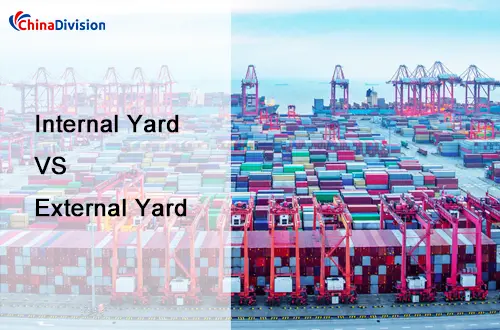The Difference Between Internal Yard and External Yard
Container yard is a key link in cargo transportation. It is responsible for the temporary storage and management of cargo, connecting ports, cargo owners and various modes of transportation. Container yard can be divided into internal yard and external yard, and there are significant differences in function and operation between the two.
Table of Contents
- What is container yard?
- The essential difference between the internal yard and the external yard
- What are the main functions of the inner yard and the outer yard?
- How to choose a suitable yard?
- Does the inner yard provide long-term storage?
- Do goods need to be declared in advance when entering the inner yard?
- Chinadivision's solutions and professional services
As a professional international logistics service provider, we will explain the difference between internal yard and external yard in detail to help you better understand and apply it, and answer the doubts you may encounter in the process of international logistics.
What is container yard?
Container yard is a site for storage, management and transshipment of containers, usually located near ports, logistics centers or large storage facilities. Its main functions include:

Temporary storage: ensure that goods have safe storage space before and after transportation.
Cargo dispatching: coordinate the entry and exit of containers to improve logistics efficiency.
Customs clearance and inspection: Some yards provide customs inspection and customs declaration services.
The essential difference between the internal yard and the external yard
The internal yard
Refers to the core area of container loading and unloading operations within the port terminal. Its layout is more compact, so that the lifting and stacking of containers can be carried out efficiently. For ship loading and unloading connection/short-term temporary storage (<72 hours), the applicable scenario is the direct shipping of loading and unloading. It is the main storage area for containers in the port, mainly used for storing import and export containers.
The efficiency of picking up goods in the internal yard is usually low because the goods need to go through customs inspection and customs clearance procedures. In addition, the space in the internal yard is limited, and it may be necessary to make an appointment to pick up goods.
Internal yard movement line: ship unloading → short-haul to the yard → truck direct pickup (average time 2.3 hours)
The internal yard focuses on the loading and unloading operations of containers, temporary storage, and coordinated operation with other terminal equipment. It is a key link in the efficiency of port operations, directly affecting the berthing time of ships and the loading and unloading speed of goods.
External Yard
Refers to the radiation area 5-50 kilometers away from the port, which is the "buffer zone" before the container enters the port. Its core functions include long-term storage/empty container turnover/customs inspection, and the applicable scenarios are transit consolidation/cross-border e-commerce overseas warehouse preparation.
The external yard has a high efficiency in picking up goods, especially the external yard with wheeled (with frame) stacking. Truck drivers can directly pick up the container with just the truck head without making an appointment in advance. However, for the external yard with ground (ground stacking) stacking, the efficiency of picking up goods will be reduced due to waiting for matching frames and looking for containers.
External yard movement line: ship unloading → terminal trailer transfer → yard storage → customer appointment to pick up the container (average time 8.6 hours)
The external yard mainly undertakes the functions of container assembly, distribution, pre-inspection, etc. For example, when goods are exported, containers from different owners will first be concentrated in the external yard for unified classification, marking and other operations, and then transferred to the internal yard according to the ship schedule. When goods are imported, the outer yard may also be used to temporarily store containers unloaded from the ship, waiting for further processing.
What are the main functions of the inner yard and the outer yard?
The main function of the inner yard
Cargo inspection: Customs and port management departments inspect and verify the goods here.
Loading and unloading operations: This is the core function of the inner yard. Through equipment such as bridge cranes, containers are lifted from the ship to the inner yard for stacking, or containers in the inner yard are lifted to the ship to complete the loading and unloading process of goods.
Temporary storage: The inner yard provides a temporary storage space while the containers are waiting to be loaded and unloaded. However, as mentioned above, this storage is usually short-term to ensure the efficiency of port operations.
Coordination with terminal equipment: The inner yard needs to work closely with other equipment on the terminal (such as tractors, reach stackers, etc.) to achieve rapid turnover and efficient operation of containers.
The main function of the outer yard
Extended storage: Provide additional storage space for imported and exported goods to reduce the pressure on the inner yard.
Cargo diversion: divert part of the cargo from the inner yard to the outer yard to improve the turnover rate of the inner yard.
Container assembly: gather containers scattered in different locations to facilitate subsequent transportation and operation. For example, some inland goods are transported to the outer yard near the port by road or rail, and together with other goods form a complete shipment batch.
Cargo pre-inspection: before the goods enter the formal process of the port, conduct a preliminary inspection of the containers in the outer yard, such as checking whether the appearance of the container is intact and whether the seal is intact, etc., to ensure that the goods meet the transportation requirements.
Transit distribution: For some goods that need to be transferred to other destinations, the outer yard can be used as a transit station to distribute and regroup the goods, and then arrange the subsequent transportation method.
How to choose a suitable yard?
If it is short-term storage and fast transfer, then choose the inner yard
If it is long-term storage and waiting for further transportation, then choose the outer yard
If customs clearance support is required, then choose a yard that provides customs declaration services
Does the inner yard provide long-term storage?
The main function of the inner yard is not long-term storage. It focuses more on temporary storage, transit and port loading and unloading operations of containers. However, in special circumstances, some yards may provide long-term storage services for a certain period of time according to the actual situation and the needs of the cargo owner, but usually additional fees are charged, and storage conditions and time are also subject to certain restrictions.
Do goods need to be declared in advance when entering the inner yard?
Yes, goods entering the inner yard usually need to be declared in advance to ensure compliance with customs regulations. Customs declaration documents can be prepared in advance to ensure that the goods enter the inner yard smoothly.
Chinadivision's solutions and professional services
For the above user concerns and pain points, our Chinadivision warehousing fulfillment packaging service provider can provide a full range of solutions.
About the pickup problem
We will formulate the best pickup plan for you based on the specific situation of the goods and transportation arrangements. If the goods are in the outer yard, we will communicate and coordinate with the relevant departments in a timely manner to speed up the circulation of goods and ensure that the goods can enter the subsequent transportation or processing process as soon as possible. At the same time, we will provide you with real-time cargo tracking information so that you can keep abreast of the dynamics of the goods.
Long-term storage needs
If you need to store goods for a long time, we can find a suitable storage site for you and assist you with the relevant procedures. We have abundant storage resources and a professional storage management team, and can provide you with safe and reliable long-term storage services. At the same time, we will provide you with a suitable storage environment and conditions according to the characteristics of the goods to ensure that the quality of the goods is not affected.
Customs clearance guidance
Our professional customs clearance team is familiar with the customs clearance policies and procedures of various countries and regions, and can provide you with accurate customs clearance guidance. Before the goods enter the inner yard, we will formulate a detailed customs clearance plan for you based on the type, quantity, value and other information of the goods, and assist you in preparing relevant customs clearance documents. We will follow up the customs clearance progress throughout the process, deal with possible problems in a timely manner, and ensure that the goods can pass customs smoothly.
The reasonable combination of the inner yard and the outer yard can save 15%-25% of the logistics costs for enterprises, while avoiding 90% of the customs clearance risks. If you encounter any problems in the relevant operations of the container yard, or need professional logistics services, please feel free to contact us Chinadivision warehousing fulfillment packaging service provider. We will escort your cargo transportation with professional knowledge and rich experience.





